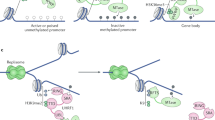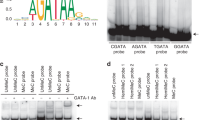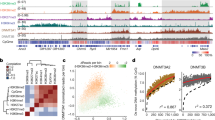Abstract
In mammals, DNA is methylated at cytosines within CpG dinucleotides. Properly regulated methylation is crucial for normal development1,2. Inappropriate methylation may contribute to tumorigenesis by silencing tumor-suppressor genes3,4,5,6,7,8,9,10 or by activating growth-stimulating genes11,12,13. Although many genes have been identified that acquire methylation and whose expression is methylation-sensitive14,15, little is known about how DNA methylation is controlled16. We have identified a DNA sequence that regulates establishment of DNA methylation in the male germ line at Rasgrf1. In mice, the imprinted Rasgrf1 locus is methylated on the paternal allele within a differentially methylated domain (DMD) 30 kbp 5′ of the promoter. Expression is exclusively from the paternal allele in neonatal brain17. Methylation is regulated by a repeated sequence, consisting of a 41-mer repeated 40 times, found immediately 3′ of the DMD. This sequence is present in organisms in which Rasgrf1 is imprinted18. In addition, DMD methylation is required for imprinted Rasgrf1 expression. Together the DMD and repeat element constitute a binary switch that regulates imprinting at the locus.
This is a preview of subscription content, access via your institution
Access options
Subscribe to this journal
Receive 12 print issues and online access
$209.00 per year
only $17.42 per issue
Buy this article
- Purchase on Springer Link
- Instant access to full article PDF
Prices may be subject to local taxes which are calculated during checkout




Similar content being viewed by others
References
Li, E., Bestor, T.H. & Jaenisch, R. Targeted mutation of the DNA methyltransferase gene results in embryonic lethality. Cell 69, 915–926 (1992).
Okano, M., Bell, D.W., Haber, D.A. & Li, E. DNA methyltransferases Dnmt3a and Dnmt3b are essential for de novo methylation and mammalian development. Cell 99, 247–257 (1999).
Baylin, S.B., Herman, J.G., Graff, J.R., Vertino, P.M. & Issa, J.P. Alterations in DNA methylation: a fundamental aspect of neoplasia. Adv. Cancer Res. 72, 141–196 (1998).
Ohtani-Fujita, N. et al. CpG methylation inactivates the promoter activity of the human retinoblastoma tumor-suppressor gene. Oncogene 8, 1063–1067 (1993).
Herman, J.G. et al. Silencing of the VHL tumor-suppressor gene by DNA methylation in renal carcinoma. Proc. Natl Acad. Sci. USA 91, 9700–9704 (1994).
Herman, J.G., Jen, J., Merlo, A. & Baylin, S.B. Hypermethylation-associated inactivation indicates a tumor suppressor role for p15INK4B. Cancer Res. 56, 722–727 (1996).
Yoshiura, K. et al. Silencing of the E-cadherin invasion-suppressor gene by CpG methylation in human carcinomas. Proc. Natl Acad. Sci. USA 92, 7416–7419 (1995).
Graff, J.R. et al. E-cadherin expression is silenced by DNA hypermethylation in human breast and prostate carcinomas. Cancer Res. 55, 5195–5199 (1995).
Esteller, M. et al. hMLH1 promoter hypermethylation is an early event in human endometrial tumorigenesis. Am. J. Pathol. 155, 1767–1772 (1999).
Herman, J.G. et al. Incidence and functional consequences of hMLH1 promoter hypermethylation in colorectal carcinoma. Proc. Natl Acad. Sci. USA 95, 6870–6875 (1998).
Issa, J.P., Vertino, P.M., Boehm, C.D., Newsham, I.F. & Baylin, S.B. Switch from monoallelic to biallelic human IGF2 promoter methylation during aging and carcinogenesis. Proc. Natl Acad. Sci. USA 93, 11757–11762 (1996).
Bell, A.C. & Felsenfeld, G. Methylation of a CTCF-dependent boundary controls imprinted expression of the Igf2 gene. Nature 405, 482–485 (2000).
Hark, A.T. et al. CTCF mediates methylation-sensitive enhancer-blocking activity at the H19/Igf2 locus. Nature 405, 486–489 (2000).
Costello, J.F. et al. Aberrant CpG-island methylation has non-random and tumour-type-specific patterns. Nature Genet. 24, 132–138 (2000).
Jackson-Grusby, L. et al. Loss of genomic methylation causes p53-dependent apoptosis and epigenetic deregulation. Nature Genet. 27, 31–39 (2001).
Birger, Y., Shemer, R., Perk, J. & Razin, A. The imprinting box of the mouse Igf2r gene. Nature 397, 84–88 (1999).
Plass, C. et al. Identification of Grf1 on mouse chromosome 9 as an imprinted gene by RLGS-M. Nature Genet. 14, 106–109 (1996).
Pearsall, R.S. et al. A direct repeat sequence at the Rasgrf1 locus and imprinted expression. Genomics 55, 194–201 (1999).
Shibata, H. et al. A methylation imprint mark in the mouse imprinted gene Grf1/Cdc25Mm locus shares a common feature with the U2afbp-rs gene: an association with a short tandem repeat and a hypermethylated region. Genomics 49, 30–37 (1998).
Kanduri, C. et al. Functional association of CTCF with the insulator upstream of the H19 gene is parent of origin-specific and methylation-sensitive. Curr. Biol. 10, 853–856 (2000).
Linn, F., Heidmann, I., Saedler, H. & Meyer, P. Epigenetic changes in the expression of the maize A1 gene in Petunia hybrida: role of numbers of integrated gene copies and state of methylation. Mol. Gen. Genet. 222, 329–336 (1990).
Goyon, C., Barry, C., Gregoire, A., Faugeron, G. & Rossignol, J.L. Methylation of DNA repeats of decreasing sizes in Ascobolus immersus. Mol. Cell. Biol. 16, 3054–3065 (1996).
Garrick, D., Fiering, S., Martin, D.I. & Whitelaw, E. Repeat-induced gene silencing in mammals. Nature Genet. 18, 56–59 (1998).
Jones, B.K., Levorse, J.M. & Tilghman, S.M. Igf2 imprinting does not require its own DNA methylation or H19 RNA. Genes Dev. 12, 2200–2207 (1998).
Tremblay, K.D., Saam, J.R., Ingram, R.S., Tilghman, S.M. & Bartolomei, M.S. A paternal-specific methylation imprint marks the alleles of the mouse H19 gene. Nature Genet. 9, 407–413 (1995).
Thorvaldsen, J.L., Duran, K.L. & Bartolomei, M.S. Deletion of the H19 differentially methylated domain results in loss of imprinted expression of H19 and Igf2. Genes Dev. 12, 3693–3702 (1998).
Stadnick, M.P. et al. Role of a 461-bp G-rich repetitive element in H19 transgene imprinting. Dev. Genes Evol. 209, 239–248 (1999).
Stoger, R. et al. Maternal-specific methylation of the imprinted mouse Igf2r locus identifies the expressed locus as carrying the imprinting signal. Cell 73, 61–71 (1993).
Lewandoski, M., Wassarman, K.M. & Martin, G.R. Zp3-cre, a transgenic mouse line for the activation or inactivation of loxP-flanked target genes specifically in the female germ line. Curr. Biol. 7, 148–151 (1997).
Herman, J.G., Graff, J.R., Myohanen, S., Nelkin, B.D. & Baylin, S.B. Methylation-specific PCR: a novel PCR assay for methylation status of CpG islands. Proc. Natl Acad. Sci. USA 93, 9821–9826 (1996).
Acknowledgements
This work was made possible through grants from the NIH and the Roswell Park Alliance to P.D.S., C.P. and to the Roswell Park Cancer Institute. The authors dedicate this work to the memory of V. Chapman.
Author information
Authors and Affiliations
Corresponding author
Rights and permissions
About this article
Cite this article
Yoon, B., Herman, H., Sikora, A. et al. Regulation of DNA methylation of Rasgrf1. Nat Genet 30, 92–96 (2002). https://doi.org/10.1038/ng795
Received:
Accepted:
Published:
Issue Date:
DOI: https://doi.org/10.1038/ng795
This article is cited by
-
DNA Methylation Analysis of Imprinted Genes in the Cortex and Hippocampus of Cross-Fostered Mice Selectively Bred for Increased Voluntary Wheel-Running
Behavior Genetics (2022)
-
Role of genomic imprinting in mammalian development
Journal of Biosciences (2020)
-
Imprinted DNA methylation reconstituted at a non-imprinted locus
Epigenetics & Chromatin (2016)
-
Genomic imprinting and its relevance to congenital disease, infertility, molar pregnancy and induced pluripotent stem cell
Journal of Human Genetics (2012)
-
A genome-wide association study for myopia and refractive error identifies a susceptibility locus at 15q25
Nature Genetics (2010)



